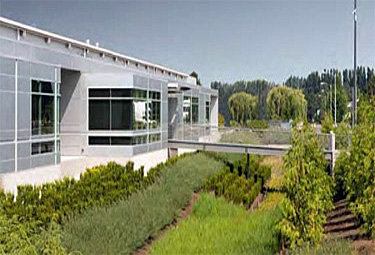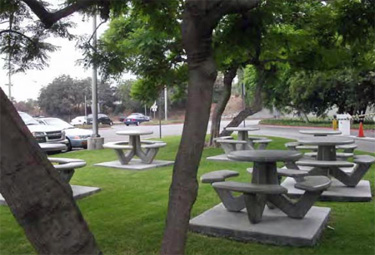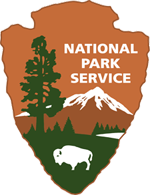Campus Renovation/Suburban Location
Introduction
This federal complex comprises six buildings, with a similar architectural style, built during the same decade. There are three multistory office buildings, two support buildings, one storage building, and multiple surface parking areas. A chain link fence encloses the entire complex. Both of the support buildings are redundant for the campus, and the storage building is underutilized. There are no exterior public spaces programmed for building tenants to eat, sit, or participate in other outdoor activities.
The main federal building houses five tenant agencies: four with an Interagency Security Council (ISC) security rating of medium, and one with a low-risk rating. The secondary building contains multiple agencies, all rated medium. The high-risk building has a single tenant agency with a high ISC security rating. All occupied federal buildings are able to achieve a minimum standoff of 50 feet from the surrounding streets.
The perimeter chain link fence disconnects the majority of the complex from the surrounding residential neighborhood. There are multiple vehicular entries and large areas of poorly lit surface parking throughout the site, making it difficult for guards to monitor both vehicles and pedestrians. To further complicate matters, the vehicular and pedestrian circulation systems are not clear, and the few wayfinding signs are confusing.
During the initial development of the complex, a portion of Second Street from Center Drive to Highway 101 was closed. An elevated freeway borders the site to the south, and recently, a lively retail corridor has been developing to the east, across Highway 101.
Existing Conditions / Site Context Plan
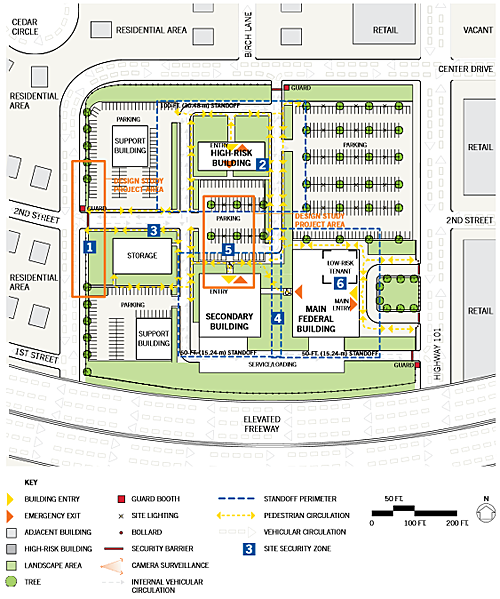
Test Case Assumptions
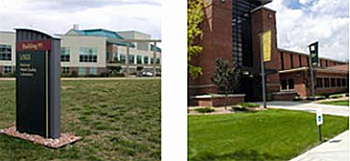
Federal campuses frequently include large open spaces, low density, pedestrian walking paths, and surface parking lots.
The site has an extensive perimeter and varying adjacent conditions and uses on each side, including residential neighborhoods. The northwest corner of the site is underutilized.
There are multiple tenants on-site with a mix of low, medium, and high ISC security ratings, requiring different minimum standoff perimeters.
The site has a confusing internal roadway system. There are three guarded vehicular entry points that require a high degree of staffing and operational support.
There are neither dedicated public spaces nor site amenities, such as benches, for the use of tenants and visitors.
There is no coordinated occupant emergency plan to guide building occupants to a safe area after they have exited their building in the event of an emergency.
The low-risk tenant in the main federal building has a high degree of direct interaction with the public.
Site Security Assessment Plan
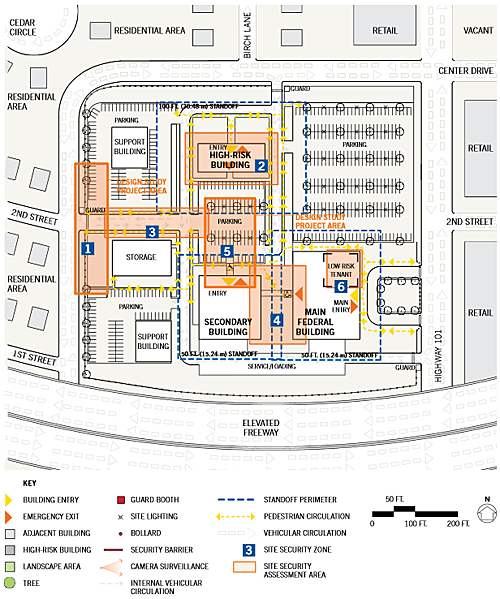
Security and Site Design Topics
To create more amenities in the neighborhood, a private developer is interested in developing a portion of the site in accordance with an agreement with the federal government. The local community would like to develop a neighborhood park.
The high-risk building needs a 100-foot standoff perimeter, per the ISC criteria.
A circulation system without a hierarchy of routes, as well as multiple building and parking entries, can confuse visitors and complicate security oversight.
Where several buildings share facilities isolated from the services of a surrounding neighborhood, public space should be provided for the comfort and convenience of tenants and visitors.
The federal complex should have an occupant emergency plan and unobstructed exits to ensure efficient egress. In an emergency, building occupants should know where to find an area of refuge to await further instruction and possible evacuation.
The needs of this low-risk but high-traffic tenant present challenges that should be addressed as part of overall building security.
Conceptual Strategy Plan
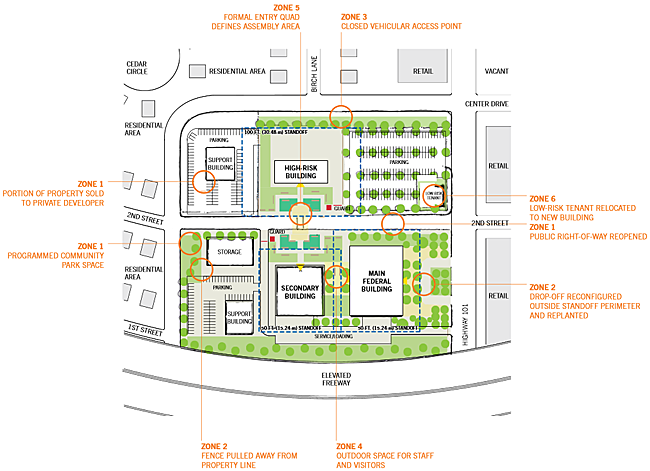
Project Area: Zone 1
Security Design Problem
A long perimeter distance can be difficult and expensive to secure properly. At certain areas of the site, the perimeter fence also needs to serve as a vehicle barrier. If space is available, the fence need not run along the property line. Pulling the fence line back provides visual relief, as well as areas for trees and hedges, which can screen the fencing. Programmed activities in landscaped areas create lively outdoor space and bring more eyes to the neighborhood to discourage criminal activity.
Programmed uses may include park use or an exercise station for employees and nearby residents. The proximity of the parking lot may offer additional opportunities, for a weekend farmers market, art fair, or other public use.
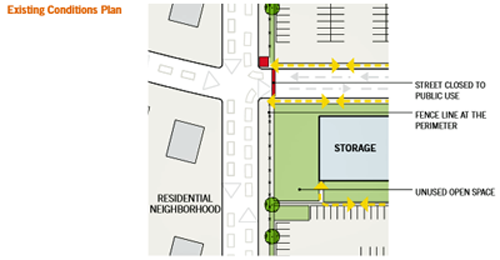
Proposed Security Design Solution
The campus perimeter has a wide landscape buffer in some areas. To activate the campus edge, the site security fence is pulled inside the property line, creating spaces large enough for a federal—community partnership to program as parks. Providing park space for the community contributes to positive public perception of the federal facility and better utilizes what would otherwise be a neglected and poorly monitored area of the site.
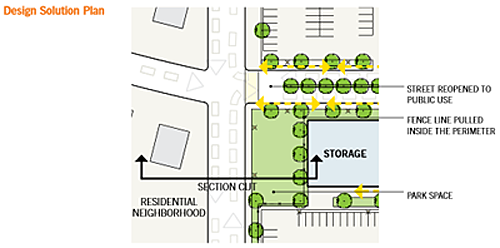
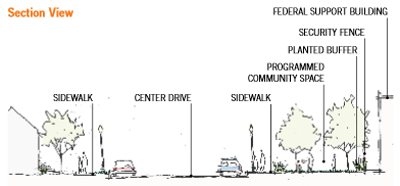
Project Area: Zone 5
Security Design Problem
A large site with multiple buildings may be confusing to navigate, especially in the event of an emergency when one or more buildings need to be evacuated. Coordinating an occupant emergency plan for all of the buildings is crucial. Occupants must have clear exit routes and an area of refuge that they can find easily. The area of refuge should be open and level, with clear sight lines to and from building exits. If the entire site ever needs to be evacuated, the area of refuge will provide an assembly point from which to direct building occupants to safety.
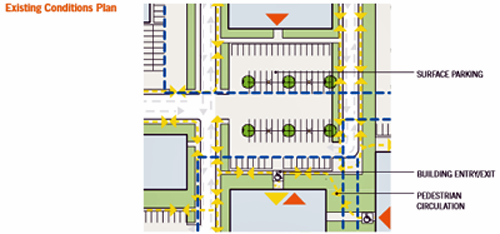
Proposed Security Design Solution
A formal entry/campus quadrangle (quad) is created perpendicular to Second Street, which is reopened to traffic. An enhanced pedestrian crosswalk provides safe crossing, and a landscaped median helps to slow traffic. The quad seating areas are placed along axial, gardenlined pedestrian paths. Clear signage and lighting lead visitors to and from their building. Reinforced site furniture along the paths establishes a perimeter, without requiring lines of bollards. The quad provides both site amenities and an area of refuge to be used in an emergency.
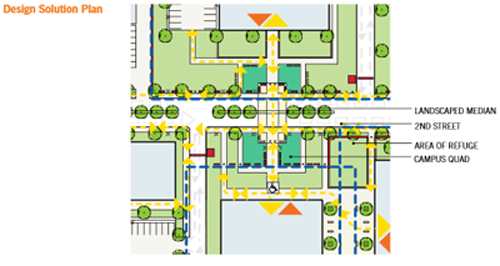
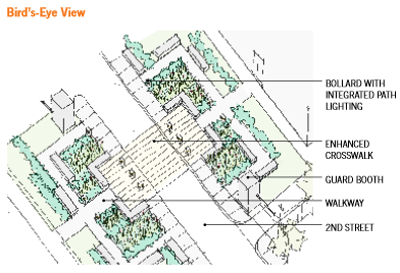
Final Concept Plan
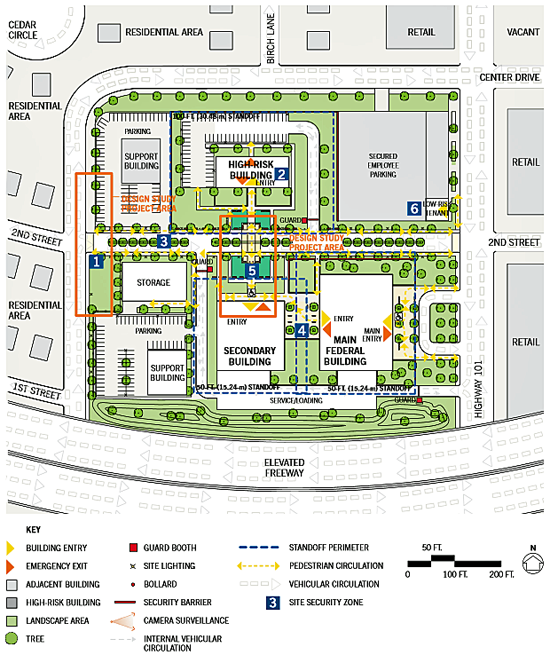
Security and Site Design Solutions
Rather than attempting to fill extra space with new tenants, it is more cost-effective for the government to sell the property that it does not need. Extra space can be programmed as parks, in partnership with community organizations. Landscape berms are used to define the edge along the elevated freeway.
The high-risk tenant now has increased security. Perimeter walls establish the 100-foot standoff. A new controlled-access point serves a parking area dedicated to the tenants of the building.
Second Street is reopened to traffic, and the site's access points are located along this road. One of the two guard booths on the south block may be automated.
A nicely scaled exterior plaza, with room for outdoor dining and other events, is now available for use by staff and visitors.
A formal entry/campus quadrangle, central to the site, is visible from each building's exit points and provides ample room for assembly in an emergency.
The low-risk tenant occupies a new building at the edge of the campus that is easily accessible to the public. A retail structure and parking garage add new amenities to the developing retail corridor along Highway 101.
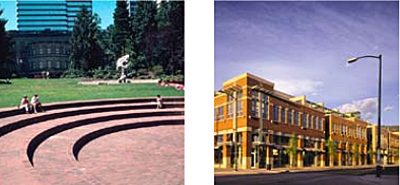
Central public spaces support casual and programmed use. Tenants with public contact may work best in a retail environment at the edge of a site.
Suburban federal complexes often encompass enormous acreage and border low-density land uses, such as residential or commercial neighborhoods. These conditions offer improvement opportunities that differ from those of their urban counterparts. In fortifying the perimeter of a multi-building complex, for example, Project Teams may find opportunities to improve the sustainability of a site. Bioswales-sloped, vegetated channels that help clean surface runoff water-both mitigate the negative impact created by substantial paved areas in such complexes and offer the security benefits of a ditch or moat. Land along the perimeter of a site provides opportunities for public use space, including small parks or sports fields.
